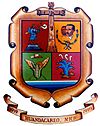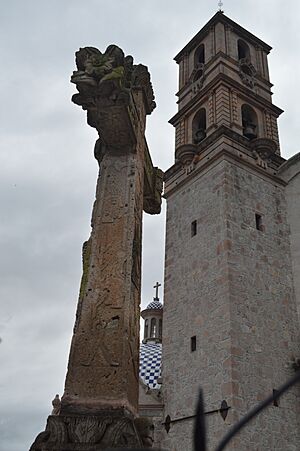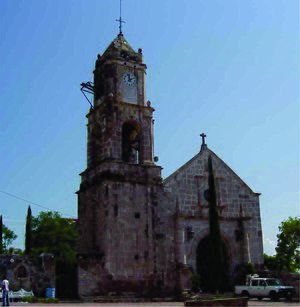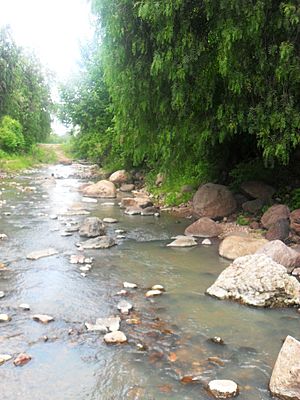Huandacareo, Michoacán facts for kids
Quick facts for kids
Huandacareo
|
||
|---|---|---|
|
Municipality
|
||
| Huandacareo | ||
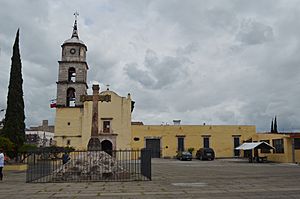
Parish of San Jerónimo in the town center
|
||
|
||
| Country | ||
| State | Michoacán | |
| Municipal Seat | Huandacareo | |
| Municipality Founded | 1919 | |
| Area | ||
| • Municipality | 95.11 km2 (36.72 sq mi) | |
| Population
(2010)Municipality
|
||
| • Municipality | 11,592 | |
| • Seat | 6,736 | |
| Time zone | UTC-6 (Central (US Central)) | |
| • Summer (DST) | UTC-5 (Central) | |
Huandacareo is a municipality in the northern part of Michoacán, a state in Mexico. It's located on the northwest side of Lake Cuitzeo. The main town, also called Huandacareo, is a small, quiet community. It's about 48 kilometers (30 miles) north of Morelia, the state capital.
Long ago, this area was part of the Tarascan state. Later, a group of monks called the Augustinians took control. Huandacareo was part of the nearby Cuitzeo area until 1919. That's when it became its own independent municipality. For a long time, the main way people made a living here was farming. They grew corn and other crops, and raised animals like pigs and chickens. Today, tourism is also important, especially because of the area's old churches and ancient sites.
Contents
Exploring the Town of Huandacareo
The town of Huandacareo is a small, rural place right next to Lake Cuitzeo. Even though it feels rural, it's not far from big cities like Morelia. It's also close to other towns like Cuitzeo and Chucándiro.
The town is built around a main plaza. On the west side of this plaza, you'll find the San Jeronimo parish church. This church has been updated a lot in recent years. In its courtyard, there's a large stone cross. Local people carved this cross a long time ago, possibly the same artists who made a similar cross in Capacho.
On the north side of the plaza is another church. Here, people honor a special figure of Christ called the Señor del Amparo. This figure is unique because it's made from joined corn stalks.
Town Celebrations and Traditions
Every year on January 8th, the town celebrates a special day. It marks the time when they stopped a group of highway robbers during the Mexican Revolution. This celebration is a big party with fireworks, fun rides, delicious food, and music.
The town also celebrates its patron saint, Saint Jerome, in September. The festivities begin on the 28th with an all-night dance. The next day, a statue of the saint is carried in a parade to nearby communities. These include Tupátaro, Tupatarillo, and San José Cuaro. After visiting these places, the statue returns to Arroyo Blanco to its chapel. This is followed by a novena, which means nine days of prayer.
The main ways people earn money in the town are through tourism, farming, and raising animals.
Discovering the Municipality of Huandacareo
The town of Huandacareo is the center of government for eleven other communities. Together, they cover an area of about 95 square kilometers (36.7 square miles). The municipality shares borders with other municipalities like Cuitzeo, Chucándiro, Copándaro, and Morelos. To the north, it borders the state of Guanajuato. The local government includes a municipal president, a syndic (a legal representative), and seven representatives called regidors.
There are eleven communities in total. Some of the larger ones include Capacho, San Cristóbal, and San José Cuaro. Capacho has about 1,966 people. They mainly make a living from fishing, making crafts, and fish farming. Capacho also has a beautiful church called the Señor de la Expiración. It has a large cross in its courtyard with images of the Virgin of Sorrows and symbols from the Passion of Christ. San José Cuaro has about 1,413 people, and their main activity is fish farming.
Even though it's a rural area, most people in the municipality live well. Less than nine percent of the population lives in extreme poverty. Most of the roads in the municipality are paved. The main road is called 8 de enero. It connects Huandacareo with other towns like Villa Morelos and Cuitzeo.
Economy and Local Crafts
Farming is still very important here. Farmers grow corn, alfalfa, chickpeas, and garlic. They also raise pigs and chickens. There's some industry too, mostly food processing and factories that make pig feed.
Local crafts include items woven from cotton, baskets, and hats made from palm leaves. In the 1990s, about eighty percent of homes had small workshops. That number is lower now, but each community still has a few workshops.
Tourist Attractions
Huandacareo has several interesting places for visitors. These include the La Nopalera archeological site, natural hot springs, the old Augustinian church, and the unique atrium crosses.
La Nopalera is an ancient site that archeologists are still digging up. It was a ceremonial center that was most active around the 12th century. People were still using it when the Spanish arrived. You can still see remains of old buildings and burial sites there.
Another ancient site is Huandacareo itself, which dates back to 1200 CE. It was also in use when the Spanish arrived in 1536. This site has walls built into hills to create walkways and plazas, making it look a bit like a fortress. You can also find ancient rock carvings, called petroglyphs, in some of the building stones.
Local Food and Celebrations
During Holy Week, most communities in the municipality have special plays and parades. Some even start their celebrations on the Friday before Palm Sunday.
If you visit, be sure to try the traditional foods! These include carnitas (fried pork), mole (a rich sauce), barbacoa (slow-cooked meat), and tamales filled with beans.
A Look at Huandacareo's Past
The name Huandacareo likely comes from the Chichimeca language. It probably means "area of discourse" or "place of speeches." Legend says the name comes from a time when a leader of the Purépecha Empire returned from a battle. His army stopped near Lake Cuitzeo, and people gave many speeches praising him.
Early History and Spanish Arrival
In ancient times, the first important culture here was Chupícuaro, one of the oldest in the region. Later, the powerful Purépecha State controlled the area.
After the Spanish arrived, Augustinian monks came to teach Christianity. They set up large farms called haciendas and used local people for labor. During the time of Spanish rule, this area was part of Cuitzeo. It produced crops like corn, wheat, and vegetables.
By the late 1700s, the population had grown enough to have its own church. During the War of Mexican Independence, the town was raided for food.
Becoming an Independent Municipality
In the 1800s, the area remained a large farm run by the Augustinians. They grew corn, a red dye called cochinilla, and onions. During the Reform War, the area supported the conservative side because of the strong influence of the Cuitzeo monastery. However, when the liberals won, the monastery lost its power, and the farms became privately owned.
In 1918, the local army protected the town from a highway robber named José Inés Chávez Garcia.
Huandacareo was part of Cuitzeo until 1919. That year, it officially separated and became its own municipality.
Geography and Nature
The municipality is in the northern part of Michoacán. It sits at an average height of 1,840 meters (6,037 feet) above sea level. The land is mostly flat, part of the Cuitzeo Depression. However, there are some hills like Manuma, Campanas, and Coronilla.
Water Sources
The most important body of water is Lake Cuitzeo. There are also two main streams called Colorado and Blanco. A dam called San Cristóbal helps to store water.
Climate and Weather
The climate here is mild. The area gets about 965 millimeters (38 inches) of rain each year. Temperatures usually range between 12.4 and 27.2 degrees Celsius (54.3 and 81 degrees Fahrenheit).
Plants and Animals
Most of the wild plants are grasses. You can also find huisache trees, opuntia cacti, and mesquite trees. The wildlife includes squirrels, cacomixtles (a type of raccoon), coyotes, rabbits, and various water birds. Many types of fish live in the local waters.
See also
 In Spanish: Huandacareo para niños
In Spanish: Huandacareo para niños


